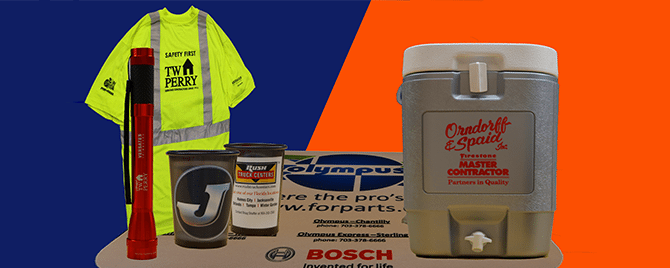The Top 8 Promotional Products of 2016
What better way to promote your company’s brand than by giving out promotional products for the world to see?


Marketing budgets are heavily scrutinized, especially when it comes to promotional items that are often a key component of marketing events and programs. This is no different for the three adform Creative customers below. When faced with the challenge of finding funding, these companies did something unique. They got someone else to pick up the tab!
By using co-op and sponsorship as a promotional tool, these companies have developed a proverbial win-win situation. They provide memorable gift items to their customers, and their vendor partners receive added exposure! If you find yourself fighting the budget battle, the advice from your peers below may help!
Ask Early, Ask Often!
As one of the leading building material suppliers in the mid-Atlantic with dozens of product categories, TW Perry relies on training events to keep contractors current. "We hold 25 events a year," explains Jennifer Purdy, Marketing Manager. "These events can have up to 170 customers, which translates into a lot of giveaway items!”
To offset the cost of all that schwag, TW Perry works closely with their vendor-partners. "Our vendors cover between 50% to 75% of the cost," notes Purdy. "We budget activities with our partners at the beginning of each year to ensure they will support the program." TW Perry purchases the items needed for the year. The sponsorship acts as a promotional tool that gives vendors exposure on the promotional items. Adform holds the inventory and ships to the different events during the year.
“It’s a win-win for everyone. So, don’t be afraid to ask your vendors,” advises Purdy. “And be sure to secure their support early in the year before budget issues can become a concern.”
Any Co-op is Good Co-op
As a leader in residential lighting control and home integration systems, Starr Systems Design works with several vendors. The Baltimore-based company uses vendor co-op funds for marketing activities. “We budget our co-op spend on expensive items first, like shows and events,” says Sarah Engel, Marketing Manager at Starr Systems Design. Of course, this includes giveaway items and polo shirts for booth staff.
In addition, Starr uses co-op funding for sales tools, demo units, and products used in exhibit booth displays. “Some vendors offer a separate co-op ‘bucket’ for these kinds of purchases,” explains Engel. “Utilizing these funds stretches our budget that much further.” Combined, the marketing co-op and product co-op represents almost half of Starr Systems Design marketing budget. “It’s significant. Everyone should ask their vendors about different co-op funding sources,” recommends Engel.
Don’t Leave Money on the Table!
At Olympus Import Auto Parts, they rely heavily on co-op dollars from their vendors. “About three-quarters of our vendors offer co-op programs,” says Jim L’Amoreaux, Purchasing Manager at Olympus. The company uses co-op funds, which are earned as a percent of sales, to buy clothing, apparel, and other promotional items. “We want our customers to remember who we are. The giveaway items get them to think of us.”
L’Amoreaux is diligent about co-op funds. He tracks every dollar that Olympus earns and uses. Each year Olympus has used all of the co-op funds available to them. “We don’t want to leave any money on the table,” adds L’Amoreaux, who manages the co-op balances of 15 vendors in a detailed spreadsheet.
Vendors have different programs. Requirements and stipulations vary. New vendors are added during the year. So, it’s important to Olympus to stay on top of each vendor’s program. “Everyone should ask their vendors about co-op programs,” advises L’Amoreaux. “It’s like free money!”
Focus on Creating Value for Sponsors
For years another adform customer used sponsorships as a promotional tool to offset costs of their events and tradeshows, including dozens of different types of promo items. Because of the logistics associated with the program, they changed the model. “They found that managing so many vendors and sponsorships became a headache,” explains Barnaby Forbes, adform Executive Director who works with the client. Managing everything from sponsorship packages to collecting artwork, to proofing all the different items became very complex.
That sponsorship program has evolved to one that reduces the logistical burden while, at the same time, providing a promotional tool for participating sponsors. “They don’t just put a logo on a lanyard. Instead, they provide quality contacts with potential customers.” Sponsorship dollars still pay for promotional items. This allows the company to focus on pairing vendors and customers. “Whether at an annual tradeshow with 350 companies or a golf outing with 30, they facilitate introductions that can lead to orders.” Understandably, this makes sponsors happy. “It gives them and immediate ROI,” adds Forbes. Sponsors seem to agree as the program has thrived since the company changed the model.

What better way to promote your company’s brand than by giving out promotional products for the world to see?

For almost four decades, we have worked closely with thousands of customers in dozens of industries. Despite their differences, adform customers have...

People are inundated by advertising ranging from ads that interrupt your favorite podcasts and delay DIY YouTube fix-it videos to ads that hijack...